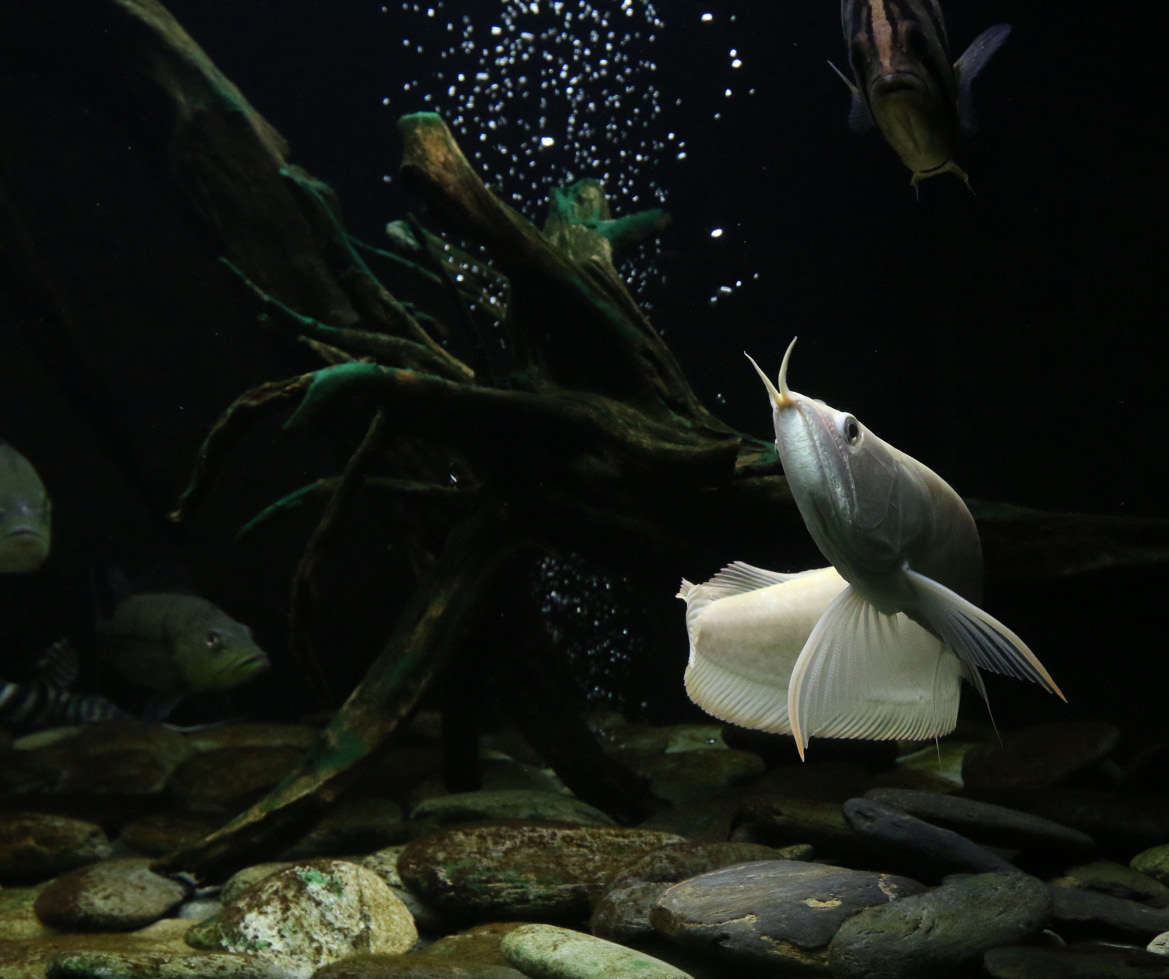A monster fish swims into popular culture and imagination
Arowanas are a rather bony freshwater fish that are from the Osteoglossidae (“bony tongue”) family, genus Scleropagus. The fish species itself is known as Scleropagus formosus, though there have been recent proposals to break the species into more species or subspecies.
Their long bodies are usually covered in metallic scales, with hues ranging from silver to a vivid red. Some also have blue hues. Their top and under-body fins have long and flexible rays, while the fins near the chest and gill areas are relatively short.
They get their Latin species name from the fact that they have a toothed bone on the floor of the mouth, which is seen as a ‘tongue’. This tongue-like bone structure bites against the teeth on the roof of the mouth.
Arowanas can be very large, growing up to nearly four feet in captivity.

Aggressive Eaters
Arowanas are aggressive predators. They are “specialized surface feeders,” and can jump more than 6 feet into the air when aiming for food, or when they have been startled. They will eat, as the saying goes, anything that moves, or that it can fit into its mouth, such as small insects, amphibians, and other fish. However, Arowanas tend to be picky eaters too, and various diets do affect their coloration.
Breeding
Generally, male Arowanas are larger in size and have larger fins, but they are hard to sex when young. Arowanas have a months-long mating ritual as they pair up, and their environment should be as large and stress-free as possible.
Arowanas are mouthbrooders, with the males carrying the embryos in their mouths.
Specied Sociability
Generally, it’s a bad idea to keep Arowanas with any fish species it can swallow. Barring that, Oscars, cichlids, and tinfoil b
arbs are among those that it can coexist with in one tank or aquarium.
The Rise of the Dragon (Fish)
According to Precious Hermosa, the first time an Arowana was recorded to have been brought to the Philippines was in 1970: a silver Arowana owned by Manuel Moreno. The first time it was caught in the wild was in 1978. However, at that point, the fish was usually in private collections.
In 1978, a shop known as PINA in Binondo started selling silver and green Arowanas. After that, Aurora Ching of North Pole in Manila started selling them too.
It was in the 1980s that Arowanas began becoming popular as aquarium fish, Dr. Glenn Angeles notes. “It was already…expensive back then,” he recalls, adding that lately, Arowanas have become much more affordable. Toto Magturo, Nigel Sia, and Arnold del Rosario agree with the historic timeline; Ernesto Ramos, Jr. and Marc Ong note, though, that it was during the turn of the century that Arowanas became as popular as they are now. “Arowanas have managed to become popular again, and, arguably, is the top aquarium fish as of now,” Arnold says.
That’s not to say, though, that there isn’t any room for improvement. “We still have a long way to go, compared to…neighboring ASEAN countries,” Dr. Glenn says. Precious agrees, adding that the hobby scene in the Philippines is “still small, compared to other neighbors in Asia.”
Nigel believes that it’s all about importers, as he believes that the more importers there are, the more prices will go down. Toto and Arnold also believe that the hobby’s expansion and popularity may be about hobbyists finding mutual support on the internet. “There are thousands of hobbyists online, based on the number of members in Facebook groups,” Arnold observes. The Philippine Arowana & Luohan Society (PALHS), for example, already has more than 12,000 members on its Facebook group page.
“The Chinese believe that the Arowana are like dragons, which is the reason why they call it dragon fish,” Toto says. “The scales of the Arowana are believed to bring good luck to one’s life.” Marc, too, was attracted to the Arowana’s draconic attributes. “For me, it is mainly because of its other name—the dragon fish,” he says. “[The term] connotes the three attributes of a dragon, such as being strong, being lucky, and being in harmony—and it can be feisty like a dragon.”
Dr. Glenn adds, “People take care of Arowanas because they believe [the fish] brings them health, happiness, and good luck…[also believing they] ward off evil, and are important for success in business.”
For Precious, it is about the fish itself. “It is a beautiful fish to keep…[it is large] but graceful, predatory but simply elegant—[this] would best describe [it].” Ernesto thinks its popularity is also about it “being a monster fish, and a top predator.”
All of our Arowana experts agree in general with Precious, as practically all of them talked about the grace and beauty of watching an Arowana. It is both relaxing, and entrancing to see the Arowana slowly swim in its tank.
This appeared in Animal Scene magazine’s July 2017 issue.







